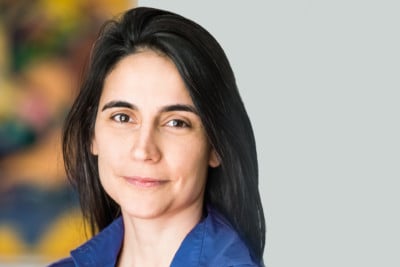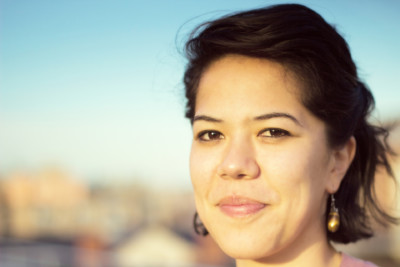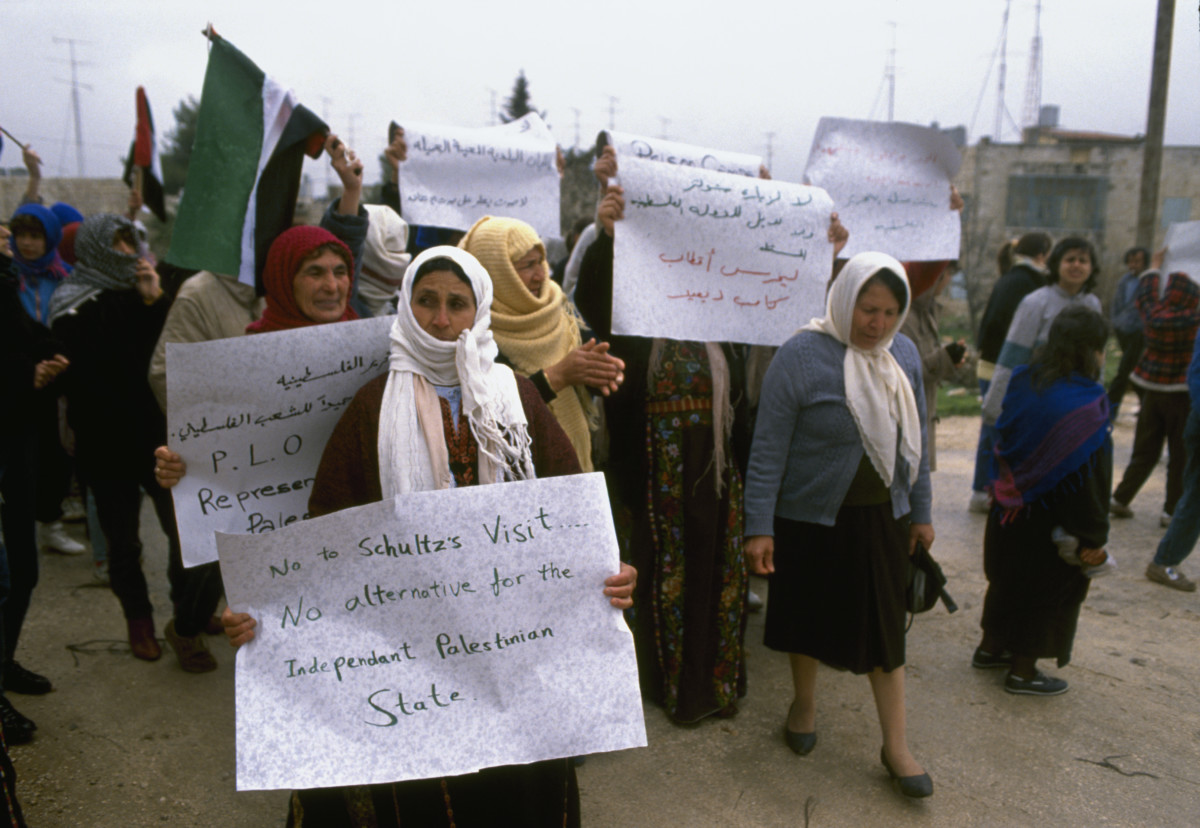The Palestinian struggle against settler colonialism has adopted many forms since the establishment of the state of Israel in 1948. These entailed individual and collective forms of violent resistance, but also extensive diplomatic efforts and an array of other nonviolent strategies.
In 1987, the first Palestinian Intifada erupted as a response to the brutal Israeli occupation of the West Bank and Gaza Strip. It included a vast assortment of tactics aimed at challenging the Israeli encroachment on Palestinian freedoms and rights, such as civilian disobedience in the forms of general strikes, boycotts, rejection of taxes and protest graffiti, as well as throwing stones and Molotov cocktails at Israeli army and police.
The Intifada also fostered a spontaneous, nonviolent, women-led collective uprising, which emphasized the importance of an intersectional approach to the Palestinian struggle.
Naila and the Uprising is a new documentary film that focuses on this unique and inspiring moment in Palestinian history through the vantage point of several of its leaders. The film was produced by the organization Just Vision, a nonprofit that highlights the power and reach of Palestinians and Israelis working to end the occupation and build a future of freedom, dignity and equality.
Julia Bacha is the director of Naila and the Uprising, a Peabody and Guggenheim award-winning filmmaker, media strategist and the creative director at Just Vision.
Suhad Babaa is the executive director at Just Vision and regularly speaks on the Palestinian struggle for justice with policy makers, community leaders, educators and students.
In this interview, Bacha and Babaa discuss the story of Naila and the Uprising, their motivations for creating the film and the lessons it can teach all those who wish to promote equality and justice in Palestine and beyond.
Yoav Litvin: Discuss your motivations for creating Naila and the Uprising. How do you perceive the film’s unique contribution within the vast number of books and documentaries dedicated to the plight of Palestinians? How does it relate to current events?
Julia Bacha: Naila and the Uprising reframes a critical historical moment — the First Intifada. The film presents this period as centered around the growth of a Palestinian national movement, but also a collective struggle for women’s liberation. The major role of women is largely unexplored in much of the available documentation or analysis of Palestinian civil society in general, and the First Intifada in particular. Naila and the Uprising seeks to rectify this gap.
We knew this was an important legacy to document, but we did not anticipate how relevant the film would be upon its release. Today, Palestinian women are still marginalized, and their role within the struggle overlooked. Women in Gaza, for example, [were] on the front lines once again during the recent Great March of Return. The broad-based popular nature of the recent Gaza protests allow[ed] women to participate and be visible to an extent not seen since the First Intifada. In fact, women organizers and activists in Gaza are making direct comparisons between the Great March of Return and the First Intifada. These events may indicate new opportunities for women to engage in the simultaneous struggles for Palestinian national and women’s liberation.
Describe a surprising discovery or epiphany you had throughout the process of filming Naila and the Uprising.
Bacha: Interestingly, my team at Just Vision and I did not set out to make a film about women leaders of the First Intifada. We wanted to make a film that revealed the incredible and highly effective civil resistance that characterized the uprising — something we knew held mythical weight in the history of the Palestinian struggle. As we delved into our research, however, we discovered a strong relationship between the incredible effectiveness of the civil resistance and the fact that women were central to leading it. Once we focused on this aspect, the story of Naila and the Uprising unfolded organically — one woman activist led to another until we had access to a whole network of female activists whose stories were waiting to be told.
This phenomenon is by no means unique to Palestinians; the leadership and central role of women is well documented in the history of civil resistance movements and not unique to the First Intifada. In fact, movements are far more likely to achieve their aims when women play a central role in civil society because women are more inclined toward the tools and strategies of nonviolent resistance than are men. We tied the experience of the women leaders we interviewed to that research in our TED Talk.
What are your aims at Just Vision and methods for achieving them? How do you coordinate between Palestinians in the shatat (i.e. diaspora) and those in Palestine to achieve your goals?
Suhad Babaa: At Just Vision, we focus on the need to draw inspiration and learn from the long lineage of grassroots civil resistance leaders in Palestine and Israel. This is clearly conveyed in our previous film projects, Encounter Point, Budrus, My Neighbourhood and The Wanted 18.
For Naila and the Uprising, we employed a team of international, Palestinian and Israeli researchers and archivists, who pored through hundreds of hours of archival news footage, and worked with Dominique Doktor and Sharron Mirsky as our lead animators. It was a five-year journey from the moment we began research to our world premiere at DOC NYC [an annual documentary film festival] in November 2017.
We believe that effective storytelling is essential for shaping the public norms around Israel and Palestine, challenging prejudices, and creating the political space for courageous policy-making to end the Israeli occupation and build a region in which both Israelis and Palestinians can thrive.
Because we work simultaneously in Palestine, Israel and the US, we aim to connect activists and advocates in their struggles. That being said, the shatat is increasingly connected with local activism, whether in Haifa, Jerusalem, the Naqab, Gaza or Jenin. We see our films as resources that can inform and inspire a broad base of individuals who care about a just future, whether they are in the region or not.
Naila and the Uprising focuses much of its attention on a spontaneously created women’s collective struggle. Discuss some of your insights on how such a struggle formed, sustained itself and effectively confronted oppression. What were some of its mistakes? What lessons are to be gleaned by other movements that seek to confront patriarchy?
Bacha: A critical point was emphasized to us in nearly every interview we conducted with women activists from the First Intifada: The women’s collective struggle did not appear spontaneously out of thin air. For years before the First Intifada erupted, women were active and organizing — in women’s groups, student unions and collectives. This organizing effectively laid the ground work for the unified struggle that emerged with the uprising. The collective nature of the struggle is part of how it sustained itself — there was such a powerful sense of unity and purpose among Palestinians during that time.
In terms of confronting oppression, the uprising was largely grounded in unarmed, mass civil resistance. This allowed space for all segments of society to participate — the young, the elderly, students and particularly women. On every level, including economic, Palestinians withheld their consent to be occupied any longer, making it unsustainable for the Israelis to continue with “business as usual.”
One poignant and ironic element of this story is how cognizant the women were about the dangers of being sidelined if they were to succeed. They understood from the very beginning (and this understanding was borne out) how deeply entrenched patriarchy is, and how difficult it is to confront and challenge patriarchy in movement-building.
Azza, a leader in the First Intifada, says in the film, “We shouldn’t have ended the Intifada until our objectives were met.” This can be applied to the uprising’s goals related to women’s liberation, as well as the national liberation goals. Ending the mass, civil resistance did not yield progress on either front.
This is as true today as it was during the First Intifada, and is equally true in movement struggles around the globe, including here in the United States. The greater the shared understanding between women and men allies that patriarchy is deeply entrenched in the power structures of so many of our movements, the more effective we can be at shifting these dynamics. Palestinian women during the First Intifada did not have enough political power to prevent their movement from being co-opted by more powerful forces. The film provokes the question: How can we design our movement structures and systems today to make that co-optation less likely?
The German playwright and poet Bertolt Brecht famously said, “Art is not a mirror held up to reality, but a hammer with which to shape it.” What are your hopes for Naila and the Uprising? Is it simply meant to be informative, or to inspire action? If so, how and who?

Bacha: At Just Vision, we believe that stories and storytelling impact how an informed public makes decisions and takes action. In that sense, we hope the film educates audiences about the power of civil resistance and the crucial role that women play at the front lines, while also serving as a cautionary tale about the deleterious effects of sidelining women leaders.
On a grassroots level, Naila and the Uprising opens up space to connect the Palestinian struggle with other movements centered on liberation, justice and equality. We hope the film will provide inspiration for movement activists all over the world — including, of course, the ongoing struggle in Palestine — and provide a space for all our movements to learn from each other and build together.
Is there a hierarchy of oppressions within Palestinian society? How does Just Vision tackle the intersectionality of these different injustices?

Babaa: As several Palestinian women in the film point out, their struggle for national liberation was and is informed by a simultaneous struggle for gender equality within their own patriarchal society. I think activist Sama Aweida put it best when she said: “We can’t be free as women unless we’re in a free country. And even if we are free of the occupation, we can’t know freedom as long as we are subjugated in our own society.” The sentiment is reminiscent of Martin Luther King Jr’s now famous quote: “No one is free until we are all free.”
At Just Vision we also believe the many layers of human emancipation are inextricably linked. It is one reason why our body of work — from Local Call, our Hebrew-language news site, to our films — has always amplified the needs, concerns and effective strategies of communities struggling for freedom, dignity and equality for everyone in the region.
See here for future screenings of Naila and the Uprising.
Join us in defending the truth before it’s too late
The future of independent journalism is uncertain, and the consequences of losing it are too grave to ignore. To ensure Truthout remains safe, strong, and free, we need to raise $43,000 in the next 6 days. Every dollar raised goes directly toward the costs of producing news you can trust.
Please give what you can — because by supporting us with a tax-deductible donation, you’re not just preserving a source of news, you’re helping to safeguard what’s left of our democracy.
